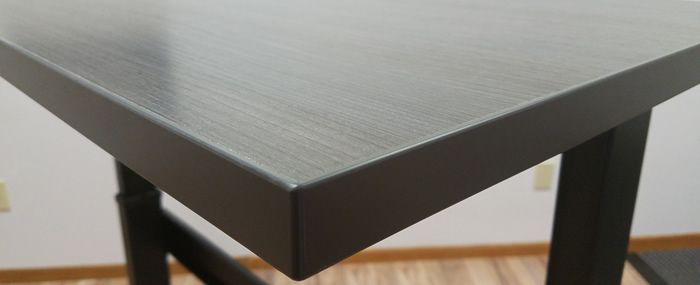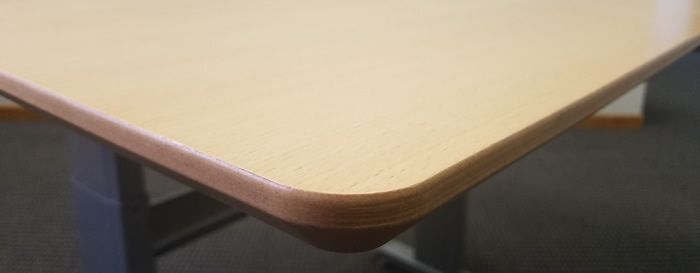Do you own a piece of furniture that is made from laminate, wood veneer or solid wood, but are unsure how to properly clean it? Don’t worry, you’re not alone. In fact, this is one of the more common questions we get from customers before they buy new furniture from our company.
Considering the size of the investment, we understand the hesitation and want you to protect your investment to ensure a long life for it. In this post, we will be covering how to properly clean and protect three of the most popular types of surfaces found on office furniture.
Full Disclaimer: We are an office furniture dealer and sell some of the products we review. To learn more about the products we sell, our review process and why you can trust us, please visit: Why we’re different. Who is BTOD.com and The Breakroom Blog?
Laminate, Wood Veneer and Solid Wood Surfaces Cleaning Links
- What is Laminate Furniture?
- How-To Maintain Your Laminate Furniture
- The Best Way to Clean Laminate Furniture
- What is Wood Veneer?
- Protecting Wood Veneer Furniture
- Best Way to Clean Veneer Furniture
- Best Way to Clean Solid Wood Furniture
1. What is Laminate Furniture?
Laminate office furniture offers a more affordable alternative to veneer and solid wood options. Some might even call this fake wood furniture. Creating laminate products relies on layering synthetic materials and creating a surface that looks like wood grain.
The result is a material that is often lighter and more stain and scratch resistant than wood, making it perfect for high-traffic areas. In order to maintain your laminate products and prolong the life of your office furniture, you will want to keep it clean.

2. Maintaining Your Laminate Furniture
First and foremost, you should regularly dust your laminate furniture. Not only will this improve the look of your office, it will also prevent dust from accumulating and potentially aggravating respiratory problems and allergies. It is important to remember that traditional dusting sprays and wood polishes won’t have the same effect on laminate surfaces because they aren’t porous. This means that the cleaner tends to simply build up on the surface and be pushed around without ever absorbing in the material. Excess cleaning can then rub off on your clothing.
To keep your laminate furniture looking great, you will also want to keep it out of direct sunlight. This will reduce any fading effects. Finally, remember what your mother always told you and use a coaster for your drinks. If you place hot or cold drinks directly on laminate surfaces, permanent rings can form and detract from the look of your furniture.
3. How To Clean Clean Laminate Furniture
When it comes to cleaning laminate wood furniture, good old soap and water is your best bet. Start with a microfiber cloth and simply dampen the cloth in warm water. As you wipe down the surface, try to move with the grain. In most cases, this will be more than enough to remove any dust and dirt. If necessary, follow up with another dry microfiber cloth to soak up any excess moisture.
If you need to do some deeper cleaning and tackle stubborn grim, try mixing mild soap and warm water. Instead of using large swiping motions, really focus on scrubbing small areas. You can even try using a light spray of non-ammonia based glass cleaner to help get things clean.
Don’ts!
The most important thing to remember is to avoid using ammonia-based cleaners on laminate and veneer surfaces. These chemicals can cause damage and create a cloudy look on the surface.
4. What are Wood Veneers?

While laminate products use synthetic materials, veneer office furniture is covered in a thin layer of real hardwood. This top layer is used to cover cheaper materials, usually particle board. The main benefit of veneer pieces is that they offer the look and feel of wood without the expense. In fact, you can even sand and stain veneer furniture if you want to give it an updated look.
5. Protecting Veneer Furniture
Although veneers tend to be less expensive that solid wood options, some of the most famous names in furniture, such as Hepplewhite and Chippendale, used veneer to create truly unique and beautiful works of art. Veneer can offer more design flexibility and opportunities for creativity. It became especially popular in mid-century furniture when teak wood was often used in Danish furniture.
If you have a prized piece of veneer office furniture, you should begin by protecting it from any damage.
- Use coasters. Condensation can damage the finish and create a cloudy appearance. If you have water rings, you can rub the area with naptha. This will remove the finish around the damaged area. Follow up with an application of oil or petroleum jelly to completely erase the mark.
The same rule applies for your hot coffee and tea mugs. Exposure to heat can cause veneers to blister. Prevent unnecessary damage mugs. Exposure to heat can cause veneers to blister. Avoid placing any drinks or hot dishes on your furniture in order to prevent damage.
- Don’t let spills sit. Veneer is applied using heavy-duty glue, but moisture can break down the glue and cause the veneer to peel off the surface. Prevent moisture from getting underneath the veneer by quickly and thoroughly cleaning up any spills.
6. How To Clean Veneer Wood Furniture
When it comes to cleaning veneer furniture, you can apply many of the same rules outline for laminate products. Avoid harsh and abrasive wood veneer cleaners and rely on simple soap and water. If you want to repair small scratches, you can apply oil polish and rub the area with a soft microfiber cloth until the scratch is no longer visible. Otherwise, avoid the frequent use of wax products to avoid build-up and simply dust the surfaces regularly.
7. The Best Way to Clean Solid Wood Surfaces

A lot of people turn to spray polishes because they smell good and leave wood with a shiny surface. However, it is important to keep in mind that using polish too often can result in a build-up of residue. Just as with laminate and veneer finishes, your best bet is to rely on a microfiber cloth that will actually pick up particles instead of pushing them around and warm water.
If you need to go beyond simple maintenance and give your wood furniture a good cleaning, then soap flakes and warm water should do the trick. Detergents have a tendency to dull wood, so invest in some soap flakes that can be dissolved in water.
For truly grimy wood furniture that has developed a sticky surface, white vinegar is the solution. Place a few drops into a cup of water for a diluted mixture and dip your microfiber cloth in the liquid. Be sure not to soak the wood surface as you clean.
Final Thoughts
Whether you purchase laminate, veneer or solid wood office furniture, many of the same rules apply. Make sure you clean surfaces regularly, avoid harsh chemical cleaners and don’t expose surfaces to extreme conditions such as hot temperatures and excessive moisture. Following a few simple practices for cleaning and maintenance and help your furniture looking great for many years to come.






Landon "Lumber Master" Edgington
great tips! I’ve been trying look for a cleaning solution for my table that is a laminate furniture. thanks for sharing this tips.